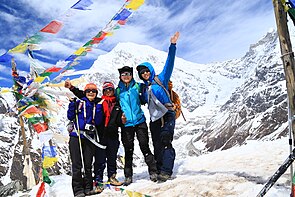Langtang


Langtang Valley (Nepali: लाङटाङ उपत्यका) also known as Lamtang Valley is a Himalayan valley in the mountains of north-central Nepal, known for its trekking routes and natural environment.
Administrative
The Langtang Valley lies in
Ecology
The Langtang Valley lies within the
Culture
Among themselves, the local inhabitants of the Langtang valley refer to each other as 'Langtangpa'. They generally follow Tibetan Buddhism, and speak a Tibetan language that is closely related to the Tibetan spoken in Kyirong, southern Tibet. The Langtangpas regard the mountain Langtang Lirung as their 'yu-lha', their local country god. However, in the state census, the Langtangpas are categorised as Tamang.[4] Langtang valley is believed to be the Beyul Dagam Namgo, one of the many hidden valleys blessed by Guru Padmasambhava.[5]
Economy
The traditional livelihoods of the Langtangpas have centered around
Access
The nearest motorable roadhead for the Langtang Valley is Syaphrubesi, which is also the base for most treks into the Langtang Valley. The distance of Syaphrubesi from Kathmandu is 80 km. But due to bad road conditions, it usually takes 6-8 hours to drive from Kathmandu to Syaphrubesi.[12] Just as for the Langtang National Park, entering the Langtang Valley requires everyone except locals to have the TIMS permit and the Langtang National Park entry permit.[13]
Tourism
The Langtang Valley trek, from Syaphrubesi to Kyanjin Gompa and back, is known to be the third most popular trek in Nepal, after the Annapurna Circuit and Everest Base Camp (EBC) treks.[14] There are several treks that go through the Langtang valley and link it to nearby valleys,[15] like the Helambu valley. In most of these treks, one can stay at local 'tea-houses', which are run by locals in nearly every village in the valley, and where one gets basic lodging and food. Around 2000, with support of the United Nations Development Programme, some of these were equipped with solar panels so that hikers could shower with warm water. There are several mountain-climbing options available too in the Langtang valley, ranging from relatively easy-to-climb peaks around 5,000 m high, such as Kyanjin Ri and Tsergo Ri, to technically challenging peaks, such as Dorje Lhakpa and Langtang Lirung.[16][17]
2015 Nepal earthquake
The
Climate change
Since the mid-2010s, Langtangpas have noticed that most natural springs in the valley have gone dry.
Langtang Himal
Langtang Himal is a mountain range in the Himalayas which includes the following peaks:[27]
| Peak | elevation |
|---|---|
| Langtang Lirung | 7,234 m (23,734 ft) |
| Langtang Ri | 7,205 m (23,638 ft) |
Dorje Lakpa |
6,966 m (22,854 ft) |
| Loenpo Gang | 6,979 m (22,897 ft) |
| Changbu | 6,781 m (22,247 ft) |
| Yansa Tsenji | 6,690 m (21,950 ft) |
| Kyunga Ri | 6,601 m (21,657 ft) |
| Dogpache | 6,562 m (21,529 ft) |
| Langshisha Ri | 6,427 m (21,086 ft) |
| Gangchenpo | 6,387 m (20,955 ft) |
| Morimoto | 6,150 m (20,180 ft) |
| Tsogaka | 5,846 m (19,180 ft) |
| Yala Peak | 5,520 m (18,110 ft) |

See also
References
- ^ "Langtang Valley Assessment - Langtang Valley, May 2015" (PDF). Retrieved August 6, 2022.
- ^ "Flora and Fauna in Langtang national park". Ministry of Forest and Environment, Government of Nepal.
- ^ "Faunal Diversity". dnpwc.gov.np. Retrieved 2021-12-23.
- ISBN 978-90-474-4337-7.
- ^ "Langtang". Nekhor. Retrieved 2022-08-06.
- JSTOR 43123727.
- S2CID 129575462.
- .
- ^ Acharya, Rajesh (2011). Mountain Tourism in Nepal (A Case Study of Langtang Rastriya Nikunja, Rasuwa) (Thesis thesis). Central Departmental of Rural Development.
- S2CID 149655369.
- ^ a b c Tamang, Gyalbu. "The story of Langtang cheese". Retrieved 2022-08-06.
- ^ "Kathmandu to Syabrubesi - Best Routes & Travel Advice". kimkim. Retrieved 2022-08-06.
- ^ "Permits Required for a Langtang Trek". www.magicalnepal.com. Retrieved 2022-08-06.
- ^ "Top 5 major highlights of Langtang Valley Trek - Trek to Langtang". 17 February 2020.
- ^ "The Best Langtang Treks - Horizon Guides". horizonguides.com. Retrieved 2022-08-06.
- ^ Hatch, Robert (2015-07-13). "Kyanjin Ri– The Highpoint of the Langtang Trek". HimalayanWonders.Com. Retrieved 2022-08-06.
- ^ "Langtang Heli-Trek and Climb". Mountain Madness. Retrieved 2022-08-06.
- ^ eberger (2015-09-28). "An Oral History of Langtang, Destroyed by the Nepal Earthquake". Outside Online. Retrieved 2022-08-07.
- ^ "Impact of Nepal Earthquake 2015 on Langthang Valley". ICIMOD. 2015-05-15. Retrieved 2022-08-07.
- ^ Pandey, Abhimanyu (May 11, 2015). "Notes from the Field: to another valley". Himal Southasian.
- ^ Thapa, Rabi (June 25, 2016). "Langtang the terrible, Langtang the beautiful". Retrieved August 3, 2022.
- ^ Lord, Austin (April 25, 2020). "The courage and endurance of the Langtangpa". Retrieved August 3, 2022.
- ISSN 2296-6463.
- ^ "Reviving the Science in Langtang Valley". ICIMOD. 2015-11-17. Retrieved 2022-08-06.
- ^ "Cryosphere research expedition to Langtang Valley, Rasuwa". ICIMOD. Retrieved 2022-08-06.
- ^ "Comprehensive community-led risk assessment and management in Langtang valley". ICIMOD. Retrieved 2022-08-06.
- ^ Carter, H. A. (1985). "Classification of the Himalaya" (PDF). American Alpine Journal. 27 (59): 109–141.
